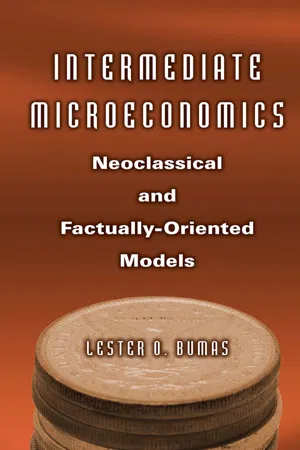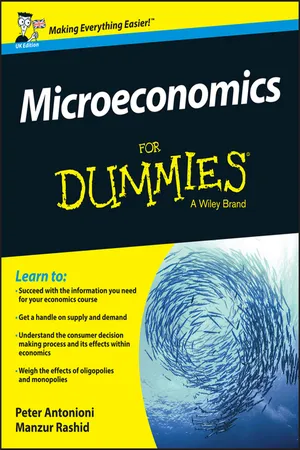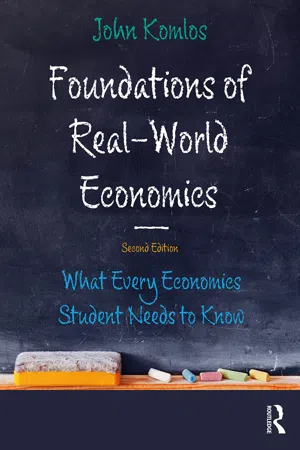Economics
Imperfect Competition
Imperfect competition refers to market situations where firms have some degree of control over the prices they charge. This can result from factors such as product differentiation, barriers to entry, or the presence of a small number of dominant firms. Imperfectly competitive markets can lead to higher prices and reduced consumer welfare compared to perfectly competitive markets.
Written by Perlego with AI-assistance
Related key terms
7 Key excerpts on "Imperfect Competition"
- eBook - ePub
Intermediate Microeconomics: Neoclassical and Factually-oriented Models
Neoclassical and Factually-oriented Models
- Lester O. Bumas(Author)
- 2015(Publication Date)
- Routledge(Publisher)
these are the markets in which competitive behavior is found . Wheat growers do not take competitive actions to win over the customers of other wheat growers. Monopolists cannot acquire the customers of other producers since they are non-existent. Grocery stores and car manufacturers do compete for customers—sometimes by price and other times by non-price competition. Third and finally, the size of the market is important in determining whether a firm is an imperfect competitor, an oligopolist, or even a monopolist. The same supermarket is an imperfect competitor in a large city, an oligopolist in a small city which has only a few, and a monopolist in a town with only one.Imperfect Competition
The concept of Imperfect Competition or monopolistic competition was independently propounded by Joan Robinson in her book, The Theory of Imperfect Competition , and Edward H. Chamberlin in his book, The Theory of Monopolistic Competition . Both books were published in 1933, the former in England and the latter in the United States. Both authors believed that their model better described the economy in general than the competitive model. Robinson and Chamberlin saw most producers as selling differentiated rather than standardized products. This gave them a measure of monopoly power. But that power is threatened by substitute products and the competition of other producers. Thus, firms generally had monopoly power threatened by competition.Market Characteristics
Put in a more orderly fashion, the attributes of Imperfect Competition are the following: (1) There are many producers in the market. (2) There are many buyers in the market. (3) There is ease of entry into and exit out of the market. (4) The product is differentiated. (5) And firms face negative-sloping demand functions and have some price-setting power.The first three attributes of Imperfect Competition—many producers, many buyers, and easy entry and exit—are also characteristics of competitive markets. The crucial difference is the fourth element: Firms in competitive markets produce a homogeneous product but those in Imperfect Competition produce differentiated products. It is product differentiation which gives the imperfect competitor some control over the price of his product, some monopoly power. Control of price, of course, is a sign of the existence of a negative-sloping demand function. Finally, ease of entry implies the threat of additional competition—further limiting monopolistic power. - eBook - ePub
- Peter Antonioni, Manzur Rashid(Authors)
- 2015(Publication Date)
- For Dummies(Publisher)
Part IVDelving into Markets, Market Failure and Welfare Economics
Many markets in information technology have unusual structures – find out what that means at www.dummies.com/extras/microeconomics .In this part …Find out why consumers love perfect competition but firms may not.Get to grips with what welfare means in economics.Discover why monopolies produce less for a higher price.Understand how things change when one side of a market knows more than the other.Passage contains an image Chapter 11
Stepping into the Real World: Oligopoly and Imperfect Competition
In This ChapterConsidering the criteria for an oligopolyModelling firms’ behaviour in oligopolyDifferentiating products to tackle competitionOligopoly is the name economists give to a type of market with only a few firms (it comes from the Greek word oligos meaning few). The classic example of an oligopoly is the supermarket industry, where a few supermarkets compete among themselves for customers and the bulk of the market is locked up between the four largest competitors: the names change – Aldi and Lidl are challenging now – but overall the market stays in the hands of few competitors. But oligopoly is visible everywhere, in industries as different as low-cost airlines and Internet services.One of the ways in which economists analyse oligopoly is by comparing it with other market structures. Compared to perfect competition, which we describe in Chapter 10 , consumers don’t get as good a deal. But compared to monopoly (which has no competition, see Chapter 13 - eBook - ePub
- Lynne Pepall, Peter Antonioni, Manzur Rashid(Authors)
- 2016(Publication Date)
- For Dummies(Publisher)
Part IVDelving into Markets, Market Failure, and Welfare Economics
Find free articles on hundreds of topics at www.dummies.com .In this part …Find out why consumers love perfect competition but firms may not.Get to grips with what welfare means in economics.Discover why monopolies produce less for a higher price.Understand how things change when one side of a market knows more than the other.Passage contains an image Chapter 11
Stepping into the Real World: Oligopoly and Imperfect Competition
In This ChapterConsidering the criteria for an oligopolyModeling firms’ strategic behavior in oligopolyDifferentiating products to soften competitionOligopoly is the name economists give to a type of market with only a few firms (it comes from the Greek word oligos meaning few). The classic example of an oligopoly is the airline industry, where a few airlines compete among themselves for customers, and the bulk of the domestic market is locked up among the four largest competitors: American, Delta, United Airlines, and Northwest. But oligopoly is visible everywhere, in industries as different as cable television services, computer and software industries, cellular phone services, and automobiles.One of the ways in which economists analyze oligopoly is by comparing it with other market structures. Compared to perfect competition, described in Chapter 10 , consumers don’t get as good a deal. But compared to monopoly (which has no competition, see Chapter 13 - eBook - ePub
The Economics of Transport
A Theoretical and Applied Perspective
- Jonathan Cowie(Author)
- 2009(Publication Date)
- Routledge(Publisher)
Chapter 7 Imperfect Competition in transport marketsOn reading this chapter, you will learn about:Learning Outcomes:- The imperfect market structures of monopoly and oligopoly and their high prevalence in transport markets
- The main sources of barriers to entry into transport markets
- The disadvantages and advantages of imperfect markets in the provision of transport services
- The tendency for competitive transport markets to veer towards imperfect market structures through company mergers and acquisitions
- One perspective of the process of competition and how industry structure may change and evolve over time.
INTRODUCTION
In this chapter the examination of competition within transport markets is further developed by introducing the idea of the imperfectly competitive market. A simple but highly accurate definition of such a market is one that breaches one or more of the assumptions of perfect competition. What this results in is a market that may have some form of competition, but that competition tends to be flawed in some respect. Consequently, operators within the market generally do not compete as fiercely as they would do in a situation of perfect competition. When left to the free market, historically most transport industries have tended towards these types of imperfect market structures, thus the two main forms, monopoly and oligopoly, are introduced in this chapter. In the course of the chapter we will also see that competition can take several different forms other than being based solely upon the price charged and/or the service offered, some of which are not always obvious as competitive strategies.In addition to the impact and effect of externalities, the issue of imperfectly competitive markets is the other major issue facing the organisation and provision of transport services. The consequences reach far beyond the direct issues covered in this chapter and extend to other matters such as the payment of subsidy, the regulation of operations and the question of private versus public ownership and control of transport services. This chapter will outline the problems as well as the potential advantages of imperfect markets in the provision of transport services. In the final section, the actual process of competition is examined, which attempts to address the question as to why so many transport markets tend towards this structure even where the best intentions of regulatory authorities have been that these markets should remain competitive. There are numerous examples where reforms have been almost wholly unsuccessful in delivering a competitive transport market in the long run. One of the principal reasons for this is that the underlying market structure, and more importantly market conduct, has proved to be far stronger than any government intervention. Understanding the basics of the competitive process is thus an important part in identifying the underlying characteristics that lead to such undesired outcomes. - eBook - ePub
Foundations of Real-World Economics
What Every Economics Student Needs to Know
- John Komlos(Author)
- 2019(Publication Date)
- Routledge(Publisher)
6 Firms and Imperfect Competition Wealth, as Mr. Hobbes says, is power.Adam Smith1We next examine aspects of the microeconomic theory of the firm that are usually glossed over in Econ 101. Standard economic theory focuses on the perfectly competitive model. This assumes that there are innumerable firms which produce a homogenous product. There are no brands since everyone produces the same generic product. So, there is no product differentiation, no differences in quality, and hence no advertisements. There is not much sense in advertising for generic cereal because one firm’s cereal is the same as all the others. These are important features of perfectly competitive markets. However, there are obviously not too many products like that.The price of a product in such a market is determined by aggregate supply and demand; consequently, no single firm has the power to influence the price. In such a case every firm is a price taker. Hence, the demand for the product of each firm is given by the market price. Firms will produce as long as they can at least break even at the given price. Consequently, firms are producing efficiently at the minimum unit cost and have just enough revenue to stay in business. In such an equilibrium, price equals both marginal and average cost and the consumer is “king”: firms produce what consumers want (see Figure 3.1 in Chapter 3 ).This is fundamentally poor pedagogy, because it emphasizes a market structure that is essentially irrelevant in today’s economy except for homogeneous raw materials in wholesale markets. In our time, practically no consumer good is produced under the above conditions. Rather, the dominant market structure is called Imperfect Competition. The concentration of production implies that firms are not price takers but retain the power to determine prices, wages, and to manipulate consumer wants (Figure 3.2 - eBook - ePub
- Israel M Kirzner(Author)
- 2002(Publication Date)
- Routledge(Publisher)
It is ordinarily assumed that competition and monopoly are at opposite poles of a single continuum. Along this spectrum, being “more monopolistic” means being correspondingly “less competitive.” At the one extreme one has the perfectly competitive market, at the other a market characterized by pure monopoly. (Theories of imperfect or monopolistic competition were designed to avoid confining economic theory strictly to these polar cases.) Each type of market is, in this perspective, characterized by a series of defining criteria. The criteria defining the polar cases are mutually exclusive; those governing intermediate cases partly overlap with those defining one or both of the polar models.My claim here is that this way of looking at competition and monopoly might be appropriate for the classification of alternative static equilibrium models. To the extent, for example, that the demand curve confronting a firm is less than perfectly elastic, this may be interpreted as reflecting a degree of “market power” possessed by the firm. With perfect competition defined in terms of total absence of such power, a degree of power expressed in a downward-sloping demand curve may plausibly come to be labelled a degree of monopoly. This was indeed the approach expressed in Abba Lerner’s classic attempt to conceive of a measure of monopoly power.12But, I wish to point out, for an approach which puts the emphasis on competition as a dynamic process, the idea of competition and monopoly being at opposite poles of a single spectrum is confused and almost incoherent. For this approach, competition is the essential defining characteristic of the market process itself. No matter what the institutional contours of the market may be, no matter what the economic power possessed by market participants may be, the market process (if such a process does exist and occur) is itself necessarily competitive. It is a process during which entrepreneurial, competitive-minded market participants, whether incumbent participants or merely potential participants, discover the true shape of market possibilities and constraints. The only situation in which competition can be said to be absent is one in which markets do not operate. Such a situation presumes, as in the centrally planned economy, the existence of institutional prohibitions on market exchanges. In any market - eBook - ePub
Barriers to Competition
The Evolution of the Debate
- Ana Rosado Cubero(Author)
- 2015(Publication Date)
- Routledge(Publisher)
Political reflection that leads to the model of Robinson was that the traditional models, the benefits tend to flow towards the capital at the expense of labour. Thus opened the doors of models with imperfections (we must not forget that this imbalance is that Schumpeter used over thirty years to defend his ‘chronic imbalance’). We only see the remainder of costs for companies. Joan Robinson and Edward Chamberlin managed to show that large firms face fixed costs arising from their investment in specialized equipment to differentiate their products from those of other companies and working with excess of capacity. The model Robinson-Chamberlin questioned that markets tend towards perfect competition. The sales are limited by price, product differentiation, fixed costs and advertising outlays. Paradoxically, Robinson’s model has no entry barriers to new suppliers within a market; just the product differentiation is the cause of the removal of rivals in the marketIn successive editions of The Theory of Monopolistic Competition, Chamberlin included his personal opinion about the Robinson model, he wrote:We may begin with the view that ‘restriction of entry’ is incompatible with perfect competition, and hence necessarily indicates monopoly or ‘imperfection’. Ms Robinson has dealt with this matter at length, and I can only record my agreement with her conclusion that restriction of entry into an industry is quite compatible with perfect (and with pure) competition, provided only that conditions within the industry are such as to make the demand curve for the output of an individual firm perfectly elastic.18From Oxford University, in 1934, Roy Harrod wrote a survey about the doctrines of Imperfect Competition, he criticized the inductive method used at this moment, mainly because the goal was to build a theoretical framework into which market imperfections could easily be fitted. One of his arguments was that: ‘Some competitors have any special advantages in production, and this supposition is not necessarily inconsistent with perfect competition’.19 He refuted the hypothesis of Imperfect Competition theory about a new competitor capturing a market; his point of view was that newcomers can be excluded, even within an industry which is operating with profits, while the entrant is reaching the optimum scale of production. He said: ‘In conditions of Imperfect Competition, long period equilibrium is consistent with lay-outs of less than the optimum size and their exploitation below their optimum capacity’,20
Learn about this page
Index pages curate the most relevant extracts from our library of academic textbooks. They’ve been created using an in-house natural language model (NLM), each adding context and meaning to key research topics.






